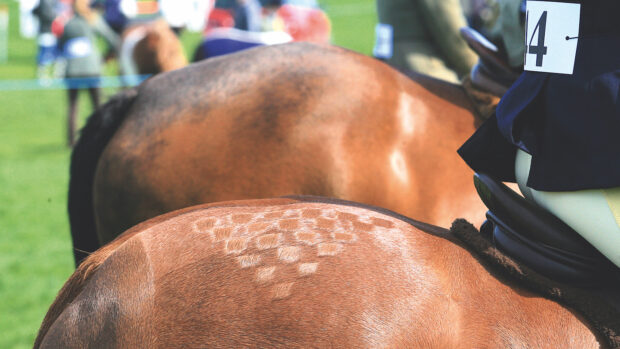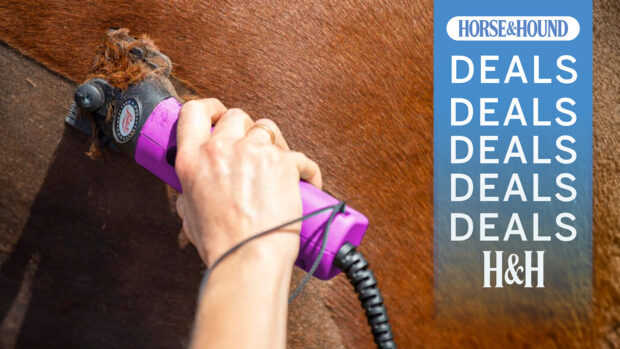A smart, tidy mane can go a long way in improving the overall look of your horse, plus, it’s easier for you to manage and maintain on a daily basis. But how exactly should you go about pulling a mane, and what are some of the pro’s top tips? Here is how to pull a horse’s mane…
How to pull a horse’s mane
1. Consider thickness
Sara Parrott and her partner Craig Elenor show a range of types and breeds of horses and ponies, many of which require well-pulled manes for plaiting purposes.
“We opt for the traditional method with a comb — separating the hair, backcombing small sections and pulling from the root — if dealing with a thick mane,” explains Sara. “If a pony has a thinner mane — like many of the Welsh breeds do — we would still backcomb the hair, but use kitchen scissors to thin it out, as traditional pulling might take out too much.”
Show horse producer Vicky Smith also opts for the traditional method of mane pulling:
“I wouldn’t use a solo comb or rake unless the horse really hates having its mane pulled,” she says. “We have a mare who is the easiest horse day to day but she finds it so uncomfortable so we use a rake on her. Sometimes you have to put safety first.”
Standard advice is to tidy manes and tails after exercise, when the horse is warm.
“It works better if the horse is hot as the hair comes out easier, so maybe look to do it after your horse has been hacked or schooled,” Sara confirms.
2. Avoid clean hair
While you might naturally think to tidy your horse’s mane after you’ve given him a bath before a competition, Sara advises against this and that it’s actually better to tackle the mane first.
“The dirtier the mane is, the better,” she says. “If the hair is too clean and slippery you can’t grab hold of it and get a good grip. Also, for the same reason, make sure the mane has no detangler or shine spray in it.”
3. Know your breed and type
If you own a mountain and moorland (M&M) pony you should wise up on specific breed standards and class expectations so you can trim and manage the hair accordingly.
Many of the native breeds — such as Exmoors, Fells, Dales and Highlands — should be shown with their manes left in a natural state and should not be subject to any trimming.
If trimming in a certain breed is permitted, the emphasis is usually that it should be minimal and left in as natural state as possible. The British Show Pony Society provides helpful summaries on how to present your M&M pony for the show ring. If in doubt, get in touch with the relevant breed society who will be happy to provide advice.
“You need to pull the mane for the type of horse you’re riding and class you’re competing in,” says Vicky. “I keep a hunter’s mane thicker than a hack’s mane, as I want the plaits to be a little bigger.
“I see lots of M&M ponies with manes which look too ‘pulled’ — with a native you must be careful as you want it to look natural. If it does look too straight at the bottom trim into it with some scissors or pull out a few strands with your fingers. If in doubt, always ask a professional for their advice.”
4. Assess the overall picture
“Craig tends to cross-tie the horses in the yard and so he can stand back and look at the overall picture of the horse,” says Sara. “This way, you are viewing it from the judge’s perspective. It sounds simple but it makes a difference.
“If looking to plait a mane, it’s essential to have the main equal and level; a well-pulled mane is the key to having balanced plaits on top of the neck.”
Likewise, Vicky would always get a horse out of the stable, tie him up and ask someone to stand at his head while pulling a mane:
“You also want to avoid getting crushed,” she says. “My girls will practice their plaiting before we go to a show, too, so you can gauge if the mane is still too thick.”
5. Other methods
Some riders and grooms may opt to use a solo comb or thinning rake to tidy a mane, especially if a horse is sensitive and objects to the traditional method.
“If using a rake the hair isn’t being pulled from the root so be careful that it doesn’t get too thin on the bottom and stay thick on top,” says Vicky.
As an alternative to pulling manes, especially on fine-coated horses whose manes need shortening rather than thinning, show producer Lynn Russell uses an old clipper blade, backcombing the top hair and nipping off a few hairs at a time from the underneath section with the blade, to give a neat but natural line.
Scissors can be used as a last resort, but the right technique is essential to avoid an ugly “club cut.” Some riders opt for a pair of round-ended scissors which cut into the mane from underneath, at an angle.
“Snip just a few hairs at a time and comb down the mane after every cut before you move on to the next hairs,” she says. “Snip at an angle or the effect is too blunt. And if you want to thin a mane, break the rules and use a metal comb every day on the underneath section and you’ll take out hair without even trying.”
At the start of the season in spring, when the bottom part of the mane might have suffered from some rug rubbing, Vicky would lightly trim the hair:
“Otherwise you will end up with an uneven mane throughout the season,” she says.
You might also be interested in:

Katie Jerram-Hunnable’s 11 steps to create your horse’s best ever plaits

6 plaiting products to help you create the perfect look

Subscribe to Horse & Hound magazine today – and enjoy unlimited website access all year round
Horse & Hound magazine, out every Thursday, is packed with all the latest news and reports, as well as interviews, specials, nostalgia, vet and training advice. Find how you can enjoy the magazine delivered to your door every week, plus options to upgrade your subscription to access our online service that brings you breaking news and reports as well as other benefits.






